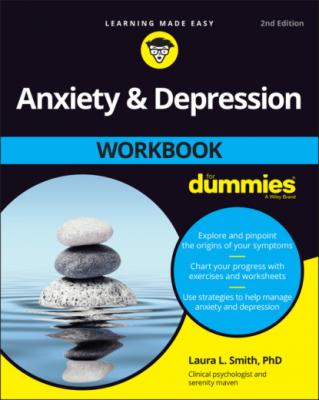Anxiety and Depression Workbook For Dummies. Laura L. Smith
Читать онлайн.| Название | Anxiety and Depression Workbook For Dummies |
|---|---|
| Автор произведения | Laura L. Smith |
| Жанр | Журналы |
| Серия | |
| Издательство | Журналы |
| Год выпуска | 0 |
| isbn | 9781119867449 |
Although physical sensations overlap in anxiety and depression, even-numbered items in the quiz above are most consistent with anxiety, and the odd-numbered items usually plague those with depression. There’s no cutoff point for indicating a problem. The more statements you check off, though, the worse your issue.
Worksheet 1-6 My Reflections
Emotions of Anxiety and Depression
Emotions erupt in response to what happens in the present, what happened in the past, and what might happen in the future. Emotional reactions involve physiological, cognitive, and behavioral responses. People across the world express six primary emotions:
Happiness
Sadness
Anger
Fear
Disgust
Surprise
From those basic emotions, more subtle expressions emerge. For example, from happiness springs joy, contentment, cheerfulness, or pleasure. From sadness, depression, gloom, despair, despondency, low self-esteem, or shame occur. Fear may bring anxiety, terror, worry, embarrassment, or panic. Disgust usually leads to distaste or feelings of grossness. Surprise is a brief emotion. What follows surprise varies depending on what brought forth the initial response. Surprise may turn into curiosity, amusement, disgust, relief, or fear.
Emotions guide behavior. Fear increases alertness and avoidance, anger produces aggression, and sadness involves withdrawal. Although most people have a variety of emotional experiences, those with anxiety or depression are likely to experience more sadness and fear, or possibly anger and disgust.
Which primary emotions do you experience the most frequently? Think about a typical day and reflect on what you’re feeling. Think about what happened just before your feeling. Were you thinking about the past or the future? Record your experience in Worksheet 1-7.
Worksheet 1-7 My Reflections
Reflecting upon Relationships
When you’re feeling down or distressed for any length of time, odds are that your relationships with those around you will take a hit. Although you may think that your depression or anxiety affects only you, it affects your friends, family, lovers, coworkers, and acquaintances. Even the strangers you interact with, such as waiters, flight attendants, clerks, and bank tellers, can suffer from your emotional state.
Worksheet 1-8 The Conflicted Connections Quiz
| 1. I don’t feel like being with anybody.2. I get very nervous when I meet new people.3. I don’t feel like talking to anyone.4. I’m overly sensitive when anyone criticizes me in the slightest way.5. I’m more irritable with others than usual.6. I worry about saying the wrong thing.7. I don’t feel connected to anyone.8. I worry about people leaving me.9. I don’t feel like going out with anyone anymore.10. I’m plagued by visions of people I care about getting hurt.11. I’ve withdrawn from everyone.12. I feel uptight in crowds, so I stay at home.13. I feel numb around people.14. I always feel uncomfortable in the spotlight.15. I feel unworthy of friendship and love.16. Compliments make me feel uneasy. |
You guessed it; there’s no cutoff score here to tell you definitively whether or not you’re anxious or depressed. But the more items you check off, the more your relationships likely suffer from your anxiety, depression, or both. Odd-numbered items usually indicate problems with depression, and even-numbered items particularly accompany anxious feelings.
Worksheet 1-9 My Reflections
Plotting Your Personal Problems Profile
The Personal Problems Profile provides you with an overview of your problematic symptoms. (If you skipped the quizzes in the previous sections of this chapter, go back and take the time to complete them; your answers to those quizzes come into play in this exercise.) The profile exercise in this section helps you identify the ways in which anxiety and depression affect you. One good thing about this profile is that you can track how these symptoms change as you progress through the rest of this book.
